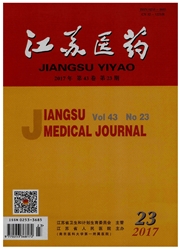

 中文摘要:
中文摘要:
目的探讨不同水平糖化血红蛋白lc(HbAlc)对冠心病(CHD)患者冠状动脉(冠脉)病变狭窄及预后的影响。方法849例首次行药物洗脱支架植入的CHD患者分为A组(HbAlc≥5.92%,286例)、B组(5.92%〈HbAlc〈6.82%,291例)和C组(HbAlc≥6.82%,272例)。Gensini评分评定患者冠脉病变狭窄程度,随访支架植入术后1年主要心脏不良事件(MACE)的发生。结果A、C组患者Gensini评分高于B组[(42.06士36.91)分、(40.59±39.59)分VS.(32.50±33.03)分](P〈0.01)。A、C组患者MACE发生率高于B组(16.3%、14.8%VS.8.6%)(Pd0.01)。糖尿病、高血压病史和HbAlc水平均为MACE发生的危险因素(P〈0.01或P〈O.05)。结论低水平HbAlc值和高水平HbAlc值均与CHD患者冠脉病变狭窄严重程度及支架植入术后1年不良预后相关。
 英文摘要:
英文摘要:
Objective To explore the impact of different levels of glycosylated hemoglobin lc (HbAlc) on coronary artery stenosis and prognosis of patients with coronary heart disease(CHD). Methods A total of 849 CHD patients underwent drug-eluting stent implantation for the first time was divided into groups of A(HbAlc≤5.92%, 286 cases), B(5.92%〈HbAlc〈6. 82%, 291 cases) and C(HbAlc≥6.82%, 272 cases). The severity of coronary artery stenosis was evaluated by Gensini score. One year major adverse cardiac events(MACE) were followed up after stent implantation. Results Gensini score in groups of A and C was higher than that in group B[(42.06±36. 91) points and (40.59±39.59) points vs. (32.50±33.03) points](P〈0. 01). Incidence rate of MACE in groups of A and C was higher than that in group B(16.3% and 14. 8% vs. 8. 6%)(P〈0. 01). Histories of diabetes and hypertension and level of HbAlc were the risk factors for MACE occurrence(P〈0. 01 or P〈0. 05). Conclusion Both of lower and higher levels of HbAlc are related with the severity of coronary artery stenosis in CHD patients and one year prognosis after stent implantation.
 同期刊论文项目
同期刊论文项目
 同项目期刊论文
同项目期刊论文
 TRPC6 is required for hypoxiainduced basal intracellular calcium concentration elevation, and for th
TRPC6 is required for hypoxiainduced basal intracellular calcium concentration elevation, and for th High glucose and interleukin 1 beta-induced apoptosis in human umbilical vein endothelial cells invo
High glucose and interleukin 1 beta-induced apoptosis in human umbilical vein endothelial cells invo Regulation of Rat Intrapulmonary Arterial Tone by Arachidonic Acid and Prostaglandin E2 during Hypox
Regulation of Rat Intrapulmonary Arterial Tone by Arachidonic Acid and Prostaglandin E2 during Hypox 期刊信息
期刊信息
